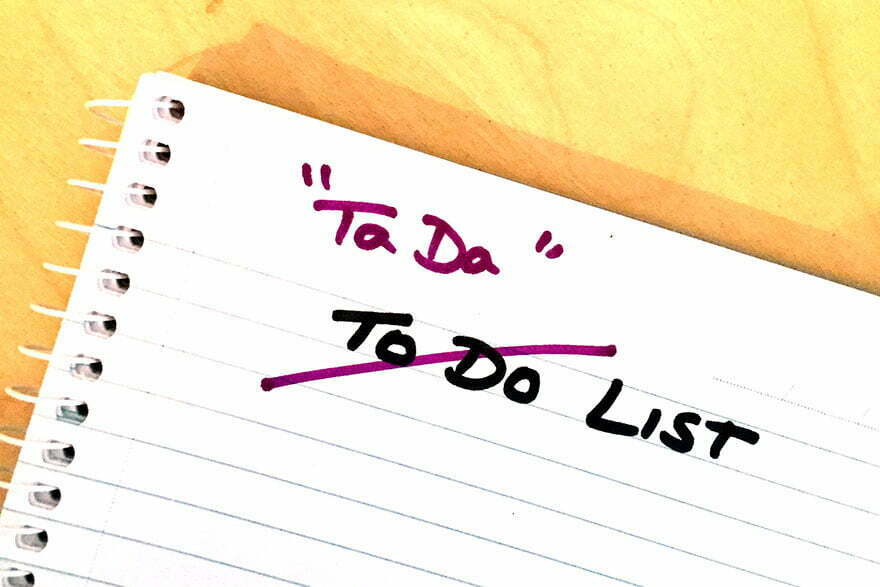Sue Langley from the Langley Group is someone I follow through her monthly updates, and I thought her idea of a ‘ta-da’ list rather than a ‘to-do’ list was a great idea. Here is how she explains why it is important to prioritise positivity.
Positive emotions are valuable for helping refuel our brains. If we are looking to try something new or create some healthy habits, positive emotions help us achieve our goals.
Research shows that positive emotions boost the neurochemical dopamine. This enables the brain to perform at its best and gets us in the right state of mind to create healthy habits. When we do something we enjoy and feel good doing it, we’re more likely to think positively about it later. This in turn inspires us to do it again, setting up an upward spiral of positive behaviour that helps us adopt a life-style change.
Barbara Fredrickson, a researcher and author of the Positivity Ratio, observed this effect, linking it with her Broaden and Build Theory. Positive emotions expand our thinking and the breadth of strategies we try, building our resources over time. They also counter the downward spiral of negative emotion if we are feel stressed or lacking willpower.
Inspired by Barbara’s latest research I have created a “Ta-Da!! List”—a list of daily actions I love and want to practice to make ongoing positive changes in my life.
Your regular To-Do List may already be full of things you know you should do. Some of these may feel motivating, some may not. Too often our lists get clogged with things we never seem to get done and we wonder why. Try incorporating activities you feel positive and enthused by and want to integrate in your everyday life. Focus on things that will boost positive emotions and wellbeing along side your regular list of tasks. Aim to tick off one or more each day.
My aim is three every day! Here are my personal five top strategies for boosting positive emotions and keeping your brain healthy and well. You may have different ones. I hope to inspire you to add some to your Ta-Da List!
Gratitude
Gratitude is one of the most enduring practices to increase happiness and wellbeing.
Practicing gratitude day to day makes us aware of the good things that happen. Studies show that when people write regularly about the things they are grateful for, their mood, coping behaviour and even physical health improves. Continuing to appreciate positive changes in life, such as a new job, friendship or goal achieved, counteracts hedonic adaption; the tendency to revert back to previous levels of happiness after positive experience has passed.
One way to practice is to start a gratitude journal. You can also keep a checklist in your mind – as long as you do it mindfully and attach meaning to the activity. This practice trains your brain to notice and savour positive experiences that happen over time, increasing your positivity.
Every night I write down the three best things that have happened to me in the day, or three things I am grateful for. Research supports doing this activity once a week, though some people find this too little. What is important is finding out what works for you. It won’t work if gratitude feels like a duty!
Use the opportunity to increase your appreciation for the people in your life. What positive feedback have you received from others? What feedback can you give them? Share your gratitude list with your friends and find out what they are grateful for too.
For more research and tips to cultivate gratitude see Thanks!: How Practicing Gratitude Can Make You Happier, by Robert Emmons. You may also like our Inspire Action Journal, which has a section to reflect on your gratitudes, or the children’s book I helped write, The Scribblybark Tree and the Dragon, featuring the Three Good Things gratitude activity.
Smiling
Smiling is one of the most immediate and natural ways to shift yourself—and other people—into a positive mood.
Our faces express our inner thoughts and feelings, even fleetingly. A genuine smile signals to other people that you are friendly and open, inviting them to connect. It triggers mirror neurons in both your brains, which allow you to feel empathy and sense what the other person is thinking or feeling.
Start the day on a positive note with a smile. You can do this by practicing smiling at yourself in the mirror for 30 seconds. Make it fun. If it doesn’t feel right to start with, you will soon be laughing at yourself and feel better naturally. The muscles you use to smile will tell your brain you are happy. Smiling, like positive emotions, is contagious.
A physical ritual or visual reminder can help you learn a positive habit like smiling. Keep a note on your bathroom mirror or buy a bracelet or something that when you see it will remind you of your commitment to your positive behaviour. I do this every morning as soon as I wake up, to kick start my day on a positive. I hold it there long enough for the positive emotions (including laughing at myself for grinning like an idiot) kicks in.
The Wonder Woman Pose
Our brain and body are interlinked. If you can shift your body you can trigger your brain to think and feel differently. That is why posture is important—it impacts your emotional state, changes the chemicals in your brain and thus the outcomes you can create.
Amy Cuddy studied how body language affects how others see us and even how we see ourselves. She showed how “power posing” can make us feel confident even if we don’t. For example, when people adopted a “Wonder Woman Pose” just before a job interview, they considerably raised their chances for success. I give the same advice to people preparing for a presentation or simply as a daily ritual.
I practice my Wonder Woman Pose every day, standing hands on hips, chest out, head up, ready to save the world. Even during the day, without the hands on hips, when I need a boost. No-one has to know I am doing it – I just lift myself up and tall and grow my energy and my emotions.
I know that the change in my physiology sends a message to my brain that creates a sense of confidence and strength. Positive emotions flood my brain, which also help me perform better that day.
Random Acts of Kindness
Acts of kindness send powerful messages that connect us with others and give meaning to our daily lives. Kindness makes both giver and receiver happier. After all, humans are social beings and naturally enjoy being altruistic. Studies show that simply by counting the acts of kindness we perform for one week we can achieve our subjective happiness. Kind acts give us positive stories to tell to help us and others savour happy times. 
Go out of your way to help a stranger who has lost their keys. It may only take a few moments of your time; to the other person it could make the difference between feeling on the verge of tears to feeling supported and energised. Practice kindness by doing five different kind things in one day. Our brains like novelty.
I like to dedicate a day to kindness and challenge myself to come up with five novel actions to surprise myself and others. It’s amazing the positive connections and experiences that happen when kindness goes viral!
Try practicing kindness with a loving-kindness meditation or watch this lovely video for some inspiration!
Curiosity
You can’t always be happy—yet you can nearly always be curious and aware.
Being curious gives you the strength to be open and accepting of whatever is happening. You approach new experiences and events with mindful awareness—the positive and beautiful as well as the challenging and upsetting. If you dial up your curiosity, it allows you to dial down anxiety. 
Curiosity is a way of learning and stimulating your brain. I find people endlessly fascinating and the more curious I am about them, the less I am concerned about myself, and the more compassion I feel toward others. I love to learn, so getting curious about the way the brain and humans work is essential to my role and inspires me to share what I learn. I also like to practice curiosity every day when I am out walking or in a natural environment or even eating a Lindt ball.
Read more about staying curious in Todd Kashdan’s Curious? Discovering the Missing Ingredient to a Fulfilling Life.
Whichever positive practice you decide to try—from this list or any other from the smorgasboard of activities available—choose what appeals to you most. Test healthy habits and activities on yourself first and if they work, keep doing them!
Sue has put together a number of great articles like this one and you can read more by joining her newsletter and exploring her website. She also has e-books and other great resources that I have downloaded and find really useful. Let us know how you get on.
